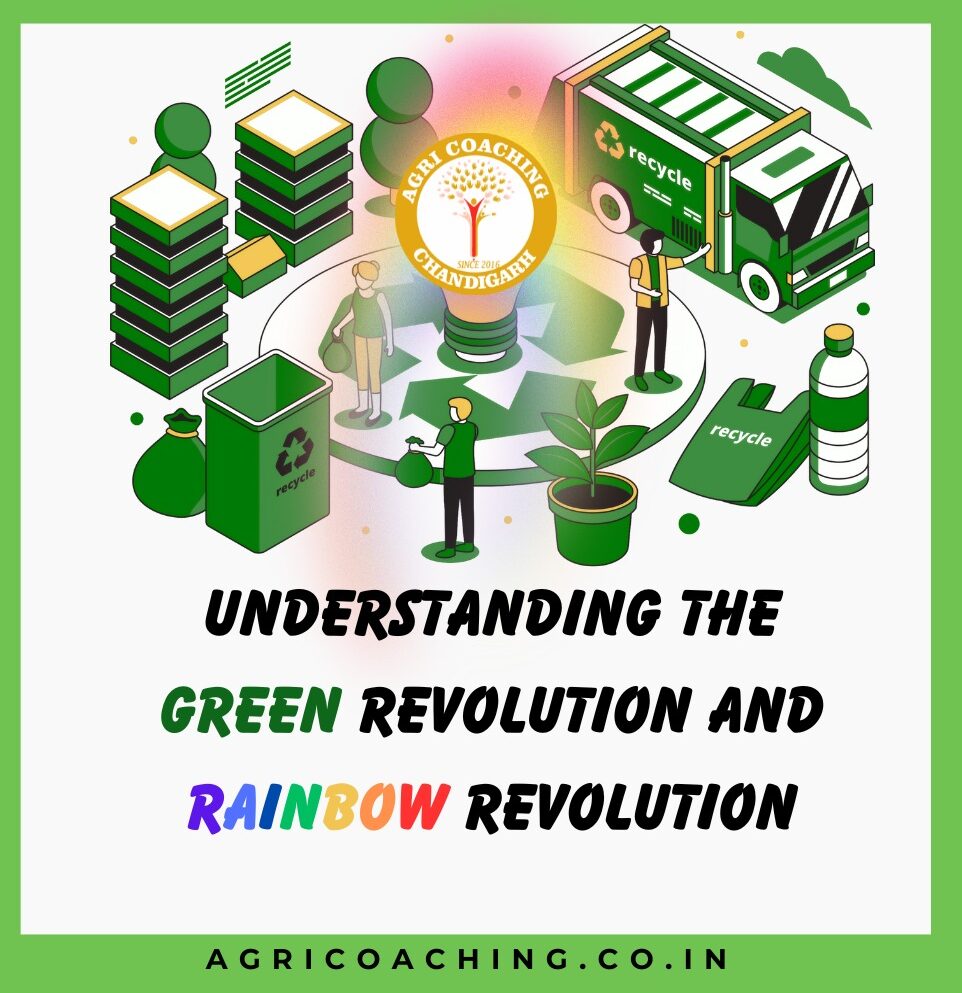Agriculture has been the backbone of India’s economy, and over the decades, various revolutions have transformed this sector, ensuring food security and economic growth. From the Green Revolution to the Rainbow Revolution, every phase has played a crucial role in shaping modern Indian agriculture. Let’s explore these transformative movements and their impact.
The Green Revolution: A Game-Changer in Indian Agriculture
The term ‘Green Revolution’ was coined by William Gaud, highlighting the dramatic increase in food grain production worldwide due to technological advancements. In India, this revolution began with the introduction of high-yielding wheat varieties in 1963 by Norman E. Borlaug, an American agronomist known as the ‘Father of the Green Revolution’.
However, in India, the success of the Green Revolution is largely credited to Dr. M.S. Swaminathan, whose pioneering efforts led to the widespread adoption of high-yield varieties of wheat and rice. This revolution transformed India from a food-deficient nation to a self-sufficient agricultural powerhouse.
Schemes Under Green Revolution (India)
To further strengthen the Green Revolution, the Indian government launched the Umbrella Scheme Green Revolution – ‘Krishonnati Yojana’ for the period 2017-2020, with a central share of Rs.33,269.976 crore. This initiative encompassed 11 key schemes aimed at scientific and holistic agricultural development to enhance farmer income, productivity and market returns. These schemes include:
- MIDH – Mission for Integrated Development of Horticulture: Promotes the growth of horticulture, enhances production and supports post-harvest management and export.
- NFSM – National Food Security Mission (Including NMOOP – National Mission on Oil Seeds and Oil Palm): Focuses on increasing the production of food grains, pulses, oilseeds and commercial crops while improving soil fertility.
- NMSA – National Mission for Sustainable Agriculture: Encourages sustainable farming, soil health management and organic farming practices.
- SMAE – Submission on Agriculture Extension: Strengthens the extension mechanism of state governments and promotes ICT-based agricultural knowledge dissemination.
- SMSP – Sub-Mission on Seeds and Planting Material: Enhances seed production, quality improvement and modernization of seed-related infrastructure.
- SMAM – Sub-Mission on Agricultural Mechanisation: Aims to increase farm mechanization, promote Custom Hiring Centres and establish technology hubs.
- SMPPQ – Sub-Mission on Plant Protection and Plant Quarantine: Focuses on minimizing crop losses due to pests and diseases while ensuring biosecurity and export facilitation.
- ISACES – Integrated Scheme on Agriculture Census, Economics, and Statistics: Conducts agricultural research, economic studies and statistical improvements.
- ISAC – Integrated Scheme on Agricultural Cooperation: Provides financial assistance to cooperatives, improves storage and marketing and supports weaker sections.
- ISAM – Integrated Scheme on Agricultural Marketing: Enhances agricultural marketing infrastructure, grading, quality certification and nationwide market integration.
- NeGP-A – National e-Governance Plan for Agriculture: Promotes farmer-centric digital services and ICT integration for improved agricultural productivity.
The White Revolution: The Dairy Industry Boom
Parallel to the Green Revolution, India witnessed a dairy revolution, famously known as the White Revolution, under the leadership of Dr. Verghese Kurien, also called the ‘Father of the White Revolution in India’. The success of Operation Flood led to India becoming the largest producer of milk in the world, significantly improving rural livelihoods and nutritional security.
The Rainbow Revolution: A Holistic Approach to Agricultural Growth
Recognizing the need for an inclusive agricultural development strategy, India introduced its first-ever National Agriculture Policy in 2000 with an ambitious goal: achieving a 4% annual growth rate and ensuring sustainable food production through the Rainbow Revolution. This concept combined multiple agricultural revolutions to enhance different sectors:
Revolution | Related Product/ Sector |
Protein Revolution | Higher Production (Technology driven 2nd Green revolution) |
Yellow Revolution | Oil seed Production (Especially Mustard and Sunflower) |
Black Revolution | Petroleum products (Increase in biodiesel / biofuel / jatropha production) |
Blue Revolution | Fish Production |
Brown Revolution | Leather/Cocoa |
Golden Fiber Revolution. | Jute Production |
Golden Revolution | Fruits (IBPS AFO 2020) / Honey Production / Horticulture Development |
Grey Revolution | Fertilizers. |
Pink Revolution | Onion Production / Pharmaceuticals / Prawn Production. |
Evergreen Revolution | Overall Production of Agriculture |
Silver Revolution | Egg Production / Poultry Production |
Silver Fiber Revolution | Cotton (RRB SO 2018) |
Red Revolution | Meat Production / Tomato Production. |
Round Revolution | Potato. |
Green Revolution | Food Grains. |
White Revolution/ Operation Flood | Milk Production. |
Sweet Revolution | Honey Production |
Test Your Knowledge with Important PYQs
- Who is known as the ‘Father of the Green Revolution’?
a) M.S. Swaminathan
b) Norman Borlaug
c) William Gaud
d) Verghese Kurien
(Answer: b) Norman Borlaug - The White Revolution is associated with which agricultural product?
a) Rice
b) Wheat
c) Milk
d) Pulses
(Answer: c) Milk - Which scheme under the Green Revolution focuses on farm mechanization?
a) ISAM
b) SMAM
c) NFSM
d) NMSA
(Answer: b) SMAM - What was the primary goal of the Rainbow Revolution?
a) Boosting milk production
b) Overall agricultural growth
c) Enhancing fishery exports
d) Increasing wheat yield
(Answer in comment section)
Frequently Asked Questions (FAQs)
Q1: What is the significance of the Green Revolution in India?
A: The Green Revolution significantly increased food grain production, making India self-sufficient in agriculture and reducing dependency on imports. It also introduced high-yield varieties, advanced irrigation and modern fertilizers, leading to economic growth.
Q2: Who initiated the White Revolution in India?
A: Dr. Verghese Kurien led the White Revolution, making India the world’s largest producer of milk through Operation Flood, which boosted dairy farming and improved rural incomes.
Q3: How does the Rainbow Revolution impact agriculture?
A: The Rainbow Revolution integrates various sectoral revolutions (such as Green, White, Blue, and Golden) to ensure overall agricultural growth, diversify food production and increase sustainability.
Q4: How can farmers access government agricultural schemes?
A: Farmers can access these schemes through government portals, local agriculture offices and cooperative societies. Many schemes also have online applications available.
Q5: What role does technology play in modern Indian agriculture?
A: Technology helps improve productivity through precision farming, digital platforms, AI-based decision-making and improved mechanization, leading to higher yields and sustainability.
To understand this topic further you can visit our YouTube video for detailed explanation
https://www.youtube.com/live/QnUefwSjBYg?si=4uHMwm7UOcajTKTd
Boost Your Agricultural Exam Preparation with Free Resources! At Agri Coaching Chandigarh, we are committed to helping students and aspiring agricultural professionals succeed in their careers. To support your learning journey, we offer free educational content, including:
✅ YouTube Videos – Comprehensive lectures, exam strategies, and concept explanations.
🎯 Informative Blogs – Regular updates on agriculture-related topics, government schemes. Important topics for exams and current affairs.
📰 Latest Agricultural News & Insights – Stay updated with crucial developments in the agriculture sector.
📌 Subscribe to our YouTube Channel for free expert guidance and exam tips!
📌 Visit our Blog Section for in-depth articles on agriculture topics and career opportunities!
Stay ahead in your preparation with Agri Coaching Chandigarh – Your trusted partner for agricultural exams! 🚀🌱






